| c.500 |
The Germanic tribe of the Rugians seem to be the same people as the Rugii of the first century who had settled on the southern shore of the Baltic. They had later migrated into Austria where they founded a kingdom which was soon subjugated by the Huns. Throwing in their lot with the Ostrogoths after being defeated in 487 by the Romano-German general and emperor, Odoacer, they migrate into Italy about 493 and soon became indivisible from the Ostrogoths. The [Bavarii](#Bavarian Confederation) confederation forms in their place. |
|
|
|
|
| Bavarian Confederation The Bavarian confederation formed in the territory that would later become Bohemia, immediately following the exodus of theLangobards towards Italy. The confederation was unusual in that it did not migrate from elsewhere but was made up from local elements, which included possibleCeltic Boii descendants and Roman settlers, along with elements of the Germanic Alemanni, Buri,Heruli, Marcomanni, Ostrogoths (following the fall of their own kingdom), Quadi, Rugii, Scirii, and Thuringians. Within a few decades the Bavarii also migrated (or expanded) southwards to occupy a larger territory which later formed Bavaria and parts of Austria. There, they were subjugated by the Franks around 555, but may not have remained fully under Frankish domination, if at all. It was not until the Carolingian conquest of 788 that independence was definitely lost. The ancient Celtic name for Bohemia was the Boiohæmum, which emerged after the Slavic incursions as Bojoheim, Baiheim, or Beheim. The Bavarian name was derived from Baioarii, Bajuvarii, and Bajjawarjos, literally meaning the 'inhabitants of the Boiic land'. |
|
|
| 508 - 512 |
Theodo I |
InBohemia. First king of the Bavarii. |
| c.520 - 550 |
The Bavarii migrate south and westwards into what will become their traditional homeland in modern south-eastern Germany and also including areas of Austria. The first three Theodos are unknown to history aside from their names, and may be manufactured to fill gaps left by rulers who have been forgotten. 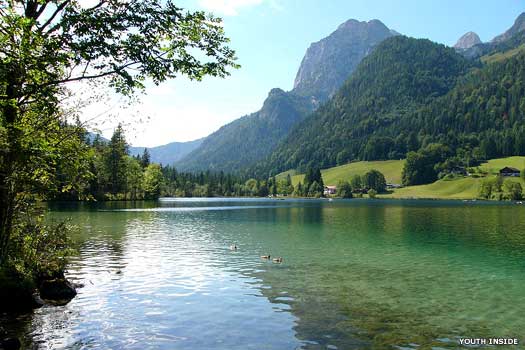 Bavaria's mixed terrain varies from dark forests to alpine mountains in the far south, with an equally mixed population of Celts, Germanics, and Romans forming this new tribal grouping in the fifth century AD Bavaria's mixed terrain varies from dark forests to alpine mountains in the far south, with an equally mixed population of Celts, Germanics, and Romans forming this new tribal grouping in the fifth century AD |
|
| 512 - 537 |
Theodo II |
|
| 537 - 565 |
Theodo III |
|
| 537 - 567 |
Theodobald |
Co-ruler. |
| 555 |
The Bavarii are conquered by the Frankish King Chlothar I, following perhaps seven years or so of Frankish dominance. A regional governor is appointed in the form of a duke, although it is not known if this founder of the Agilolfing dukes is a Frank or a Bavarian. It may be the case that he initially governs while the reigning Bavarian kings retain some semblance of power, but possibly not control. |
|
| 550 - 590 |
Garibald I / Garivald |
First of theFrankish-appointed Agilolfing dukes. |
| 590 - 591 |
Theodelinda, daughter of Garibald, rules theLombard kingdom of Italy briefly upon the death of her husband. She is a Nicene Christian, an adherent of the Roman Church, and is very important in terms of increasing the importance and reach of the Catholic church in Italy over Arian Christianity. Thanks in large part to her efforts in winning converts the church at Rome is able to secure its primacy in Italy and can begin to focus its attention on making fresh converts elsewhere. |
|
| 590 - 595 |
Grimwald I |
|
| 591 |
Tassilo is appointed king of the Bavarians byFrankish King Childebert II of Austrasia in order to end a war between Bavarians and Franks which had begun under Garibald I. The act also reaffirms Frankish control of the Bavarians. The relationship of Grimwald I to any of these participants is unknown, as is his fate during and after the appointment of a Bavarian king. |
|
| 591 - 609 |
Tassilo I |
King of the Bavarians. |
| 609 - 640 |
Garibald II |
Son. Duke of the Bavarians. |
| 609 - 630 |
Agilolf |
|
| 609 |
The inclusion of Agilolf is uncertain as he is not shown in all sources. He may be a replacement for a lost duke. Whether he co-rules or acts as a regent is not known. Coincidentally, perhaps, there is an Agilulf, king of the Lombards, with whom the Bavarians have close relations during this period. |
|
| 640 - 680 |
Theodo IV (I) |
|
| 680 - 702 |
Theodo V (II) |
Duke of the Bavarians. |
| Lantpert of Bavaria |
Son. Murdered (Saint) Emmeram of Regensburg. |
|
| c.700 |
Married to a daughter of Theodo of Bavaria, Duke Godefred of Alemannia (Gotfried of Allemania) is a member of the House of the Agilolfing, Bavaria's governing family. In a document dated to the year 700 in Cannstatt, and at the request of a priest named Magulfus, Godefred donates the castle of Biberburg to the monastery of Saint Gall. His sons, Lanfred and Theodobald, have the support of Pepin of Herstal, Frankish mayor of the palace, and succeed him as dukes of Alemannia (perhaps following a short delay). |
|
| 702 - 725 |
Theodobert / Theudbert |
Brother. Duke in Salzburg. |
| 702 - 723 |
Grimwald II / Grimoald |
Brother. Duke in Freising. |
| 702 - 715 |
Theodobald |
Brother. Duke in parts of Bavaria. |
| 702 - 719 |
Tassilo II |
Brother. Duke in Passau. |
| 725 - 737 |
Hubert / Hugbert |
Son of Theodobert. Duke of Bavaria. |
| 737 - 748 |
Odilo |
Son of Gotfried of Allemania. Defeated by the Franks. |
| 743 - 744 |
TheCarolingian mayors of the Merovingian palace, Pepin the Short and Carloman, march against the Bavarian Agilolfings (who refuse to end their support for the Merovingians), before turning north to attack the Saxons. Odilo is allowed to remain as duke. |
|
| c.745 - 748 |
Prince Borut of neighbouring [ Khorushka](EasternCarinthia.htm#Principality of Khorushka) faces continued attacks from the resurgent Avars. He appeals to the powerful Duke Odilo for help, but this is provided only on condition that Borut accepts Bavarian overlordship and converts to Christianity. He accepts both conditions, becoming one of the very few princes of Khorushka to convert to Christianity. |
|
| 748 |
Grifo, the son of Charles Martel, the late Carolingian mayor of the palace, by his second wife now escapes from imprisonment in a monastery, a punishment organised by his half-brother, Pepin III the Short. Grifo receives support from Duke Odilo of Bavaria, which seems to see him commanding the Breton March for around a year. Upon Odilo's death late in 748, Grifo briefly seizes command of the Bavarians before being ousted by Pepin. His fight continues until he is killed in battle in 753.  Under Charlemagne's leadership, the Franks greatly expanded their borders eastwards, engulfing tribal states, the Bavarian state and its satellite, Khorushka, and much of northern Italy, with the Avars now an eastern neighbour (click or tap on map to view full sized) Under Charlemagne's leadership, the Franks greatly expanded their borders eastwards, engulfing tribal states, the Bavarian state and its satellite, Khorushka, and much of northern Italy, with the Avars now an eastern neighbour (click or tap on map to view full sized) |
|
| 748 |
Grifo |
Frankish half-brother of Pepin. Commanded the Breton March. |
| 748 - 788 |
Tassilo III |
Infant son of Odilo, installed by Pepin of the Franks. |
| Theodo |
Son. Became a monk. |
|
| 788 - 889 |
With the Carolingians growing in power, Tassilo is deposed and the Bavarians are subsumed completely within the kingdom and subsequent empire (along with their vassal, the principality of [ Khorushka](EasternCarinthia.htm#Principality of Khorushka)). This remains the case until that empire finally fragments in 889, although from 843 Bavaria is generally controlled by the Eastern Franks. |
|
| 815 - 817 |
Lothar I |
Son of Frankish Emperor Louis 'the Pious'. Later king of Italy. |
| fl 838 |
Ernest |
Margrave of the Bavarian Nordgau. |
| 838 |
Gebhard of Logenahe, count of Nieder-Lahngau in Hesse, is a 'leading man of the [Eastern] Franks' and brother-in-law to Ernest, margrave of the Bavarian Nordgau. He may also be the son of Odo I, count of Orléans if he is identical with Udo the Elder, count of the Lahngau until 826. However, given the dates, he may instead be Odo's grandson. |
|
| 840 - 843 |
Louis 'the Pious' wills the Frankish empire to his sons, but tries to ensure that the eldest gains the biggest share, in order to avoid the fragmentation of territory which so weakened the Merovingians. Lothar receives Middle Francia (the Rhine corridor including the kingdom of[Burgundy](FranceBurgundy.htm#Frankish Kingdom of Burgundy), and Italy); Charles 'the Bald' receives [Western Francia](FranceFranks.htm#Western Franks) (France and the duchy of Burgundy); and Louis the German receives Eastern Francia (Germany, including Alemannia, Bavaria, [ Khorushka](EasternCarinthia.htm#Principality of Khorushka), andSaxony, plus regions that are already emerging asFranconia andThuringia). However, Lothar initially claims overlordship over all three regions and Louis and Charles have to go to war to convince him to relent. The Treaty of Verdun, signed in 843, recognises the division of the empire. 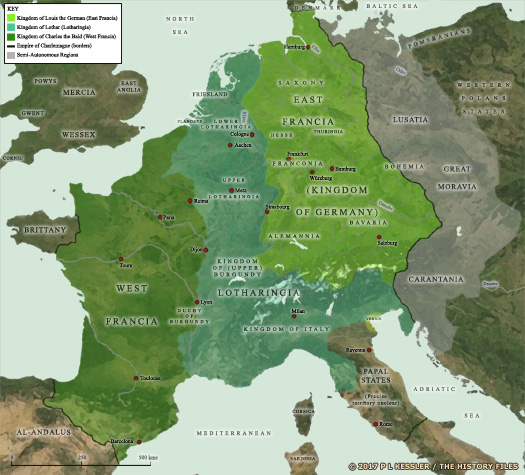 King Louis 'the Pious' of the Frankish empire attempted to leave the empire intact for his eldest son, Lothar, but the others rebelled at the idea. The treaty of Verdun in AD 843 confirmed the official division of the empire between Charlemagne's three surviving grandsons (click or tap on map to view full sized) King Louis 'the Pious' of the Frankish empire attempted to leave the empire intact for his eldest son, Lothar, but the others rebelled at the idea. The treaty of Verdun in AD 843 confirmed the official division of the empire between Charlemagne's three surviving grandsons (click or tap on map to view full sized) |
|
| 876 |
The death of Louis the German, king of East Francia, results in his territory being divided between his three sons. This is something that he had already foreseen, and portions of territory had been appointed to each of them in 865. Now in a peaceful succession, Carloman inherits Bavaria and the Ostmark, Louis the Younger gains Franconia, Saxony, and Thuringia, while Charles 'the Fat' succeeds to Rhaetia and Alemannia (Swabia). As the oldest son, Carloman also retains de facto dominance over the Eastern Franks as a whole. |
|
| 876 - 880 |
Carloman of Bavaria / Charles |
Son of King Louis theGerman. King ofItaly & part of Lotharingia. |
| 879 |
Carloman suffers a debilitating stroke just two years after gainingItaly. Unable to rule in anything but name and having no legitimate offspring, he divides his holdings between his brothers. Louis the Younger gains Bavaria while Charles 'the Fat' gains Italy. Carloman's illegitimate son, Arnulf, becomes duke of [Carinthia](EasternCarinthia.htm#Duchy of Carinthia). |
|
| 880 - 882 |
Louis the Younger |
Brother. Ruled part of Lotharingia.Empire (901-905). |
| 882 |
Louis the Younger dies and Charles 'the Fat', as the last remaining of the three brothers, inherits his territories of[Bavaria](#Bavarian Confederation),Franconia,Saxony, and Thuringia, thereby reuniting East Francia following its division in 876. |
|
|
|
|
| Duchy of Bavaria (Welfs) AD 889 - 1180 In 888, Bavaria emerged as a stem duchy from the fragmentation of the Frankish empire, when the Germanic Roman Emperors gained undisputed command over the Germany section of the empire. Judith of Bavaria was the mother of Charles II the Bald of the [Western Franks](FranceFranks.htm#Western Franks). (Additional information from Geschichte Kärntens bis 1335 (Vols 1 & 2), A Jaksch (Klagenfurt, 1928-29), from Geschichte Kärntens (Vols 1 & 2), C Fräss-Ehrfeld (Klagenfurt, 1984-94), from Dynasties of the World, John E Morby, and from The New Cambridge Medieval History: Volume 3, c.900-c.1024, Timothy Reuter & Rosamond McKitterick (Eds).) |
|
|
| 889 - 907 |
Liutpold |
|
| 907 - 937 |
Arnulf the Bad |
|
| 907 - 955 |
Austria passes to the Magyars, until the latter are defeated by Saxon emperor Otto I. |
|
| 927 - 947 |
The region of [Carinthia](EasternCarinthia.htm#Duchy of Carinthia) (Carantania) comes more or less under the control of Bavaria as the Carinthian March (a border territory). Following this, a duchy is gradually established during the tenth century, although it is not formally established until 976. Count Berthold of the Bavarian Luitpoldings is granted ducal rights over Carinthia in 927, by King Henry the Fowler of Germany. |
|
| 937 |
A massive invasion is conducted by theMagyars as they sweep around in a giant circle through central and Southern Europe. They begin from their base in Pannonia to enter into and ravage Bavaria, [ Swabia](GermanySwabia.htm#Dukes of Swabia),Saxony,Franconia, andThuringia within theEast Frankish kingdom. From the Aachen area, the Magyars advance deep into the [West Frankish](FranceFranks.htm#Western Franks) kingdom, the kingdom of Provence, and then the territory of theMiddle (Italian) Franks. They attack Tuscany and the Papal States as far south as Naples, before returning to their adopted Hungarian homeland. |
|
| 937 - 938 |
Eberhard |
Quarrelled with Otto the Great and removed. |
| 938 - 947 |
Berthold Luitpolding |
Brother of Arnulf of Carinthia. Count Berthold of[Carinthia](EasternCarinthia.htm#Duchy of Carinthia) (927). |
| 947 - 955 |
Henry I Luitpolding |
Son. Duke of[Carinthia](EasternCarinthia.htm#Duchy of Carinthia) (947-955 & 976-978). |
| 953 |
Feeling that his position is threatened by the marriage of his father, Otto I of Saxony, to Adelaide, heiress of Italy, Ludolph of[Swabia](GermanySwabia.htm#Dukes of Swabia) joins forces with his brother-in-law, Conrad the Red, duke ofLorraine, in revolt. Ludolph is supported by the Swabians, but Conrad fails to gain the same support from his own subjects. Otto I and Henry I of Bavaria defeat the rebellion. |
|
| 955 - 976 |
Henry II the Quarrelsome |
Duke of[Carinthia](EasternCarinthia.htm#Duchy of Carinthia) (955-976). Rebelled and deposed. |
| c.960 |
The march of Austria, created from former Bavarian territory which had already been captured from early Hungary in 955, is recognised around this date as a margraviate. It sits on Bavaria's north-eastern border, immediately above[Carinthia](EasternCarinthia.htm#Duchy of Carinthia). |
|
| 962 |
With the accession of the Saxon king, Otto I, the power of the Germanic Roman empire is confirmed. Otto is quite vigorous in establishing new counties and border areas within and without the empire's borders. The county of Ardennes under Sigfried gains the stronghold of Lucilinburhuc (the later Luxemburg), and Arnulf I the Elder is restored in Flanders, but useful buffers against the Western [ Franks](FranceFranks.htm#Western Franks). 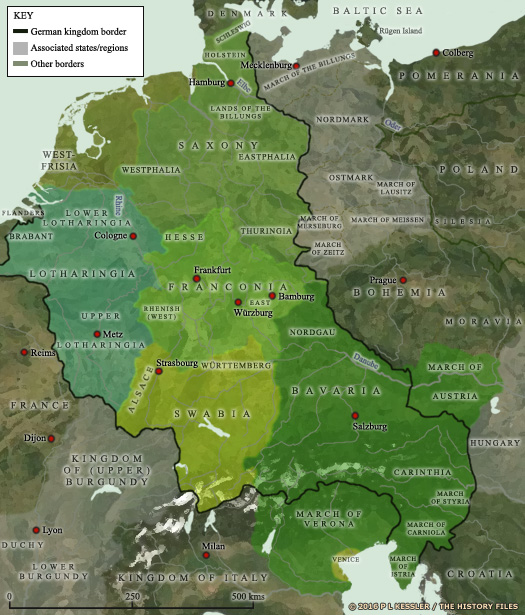 Germany in AD 962 may have had its new emperor to govern those territories which are shown within the dark black line, but it was still a patchwork of competing interests and power bases (click or tap on map to view full sized) Germany in AD 962 may have had its new emperor to govern those territories which are shown within the dark black line, but it was still a patchwork of competing interests and power bases (click or tap on map to view full sized) |
|
| At the same time,Saxony gains Hermann Billung as its duke, charged with maintaining the duchy's eastern borders and expanding them further to the east, alongside the recently-created North March. Perhaps as a reaction to this or as the culmination of a process that is already heading that way, the duchy of Poland is formed around the same time. |
|
|
| 976 |
Henry the Quarrelsome, grandson of Henry I ofGermany, rebels against Holy Roman Emperor Otto II. As a result, Henry is deprived of his Bavarian title and possessions. Otto I, duke of [ Swabia](GermanySwabia.htm#Dukes of Swabia) is created duke of Bavaria in his place, easily done as Swabia and Bavaria neighbour each other. [Carinthia](EasternCarinthia.htm#Duchy of Carinthia) is formally separated from Bavaria by Otto II and made a duchy in its own right - one of many large-scale reorganisations of German lands which also involves the creation of the stem duchies. The border area along Carinthia's eastern edge now becomes the new Carinthian March or Hungarian March until it is re-categorised as the March of [Styria](EasternStyria.htm#Slav Kingdom in Carinthia). |
|
| 976 - 982 |
Otto I |
Grandson ofHRE Otto I. Duke of[Swabia](GermanySwabia.htm#Dukes of Swabia) (973) &[Carinthia](EasternCarinthia.htm#Duchy of Carinthia) (978). |
| 978 - 995 |
Bavaria rules again over the duchy of[Carinthia](EasternCarinthia.htm#Duchy of Carinthia), first under Otto I, duke of Bavaria and [Swabia](GermanySwabia.htm#Dukes of Swabia), and then successively under Henry III and Henry II. Otto seems not to hold the title of duke of Carinthia himself. Instead Henry III fills the position, although some modern sources show it as being Otto. |
|
| 983 - 985 |
Henry III the Younger |
Duke of[Carinthia](EasternCarinthia.htm#Duchy of Carinthia) (978-985). |
| 985 - 995 |
Henry II the Quarrelsome |
Restored. Duke of [Carinthia](EasternCarinthia.htm#Duchy of Carinthia) (989-995). |
| 995 - 1005 |
Henry IV the Saint |
HRE Henry II (1002-1024). |
| 1002 |
Henry's election as the German emperor is opposed by the Conradine duke of[Swabia](GermanySwabia.htm#Dukes of Swabia), Herman II. Herman had seen himself as a suitable candidate for the title. Unsuccessful, Herman sees the duchy of Alsace taken out of his control by the new emperor. |
|
| 1005 - 1009 |
Henry V |
Henry I of Luxemburg (998-1026). |
| 1009 - 1017 |
Henry VI the Black / Henry of Franconia |
Son of Conrad II. |
| 1017 - 1026 |
Henry V |
Restored? Died. |
| 1026 - 1042 |
Henry VI the Black / Henry of Franconia |
Restored? Duke of[Carinthia](EasternCarinthia.htm#Duchy of Carinthia), Franconia, [Swabia](GermanySwabia.htm#Dukes of Swabia), & HRE Henry III. |
| 1035 |
Count Siegfried I of Spanheim (1010-1065) serves with distinction under Holy Roman Emperor Conrad II (the Salian) against Adalberon of Eppenstein, duke of[Carinthia](EasternCarinthia.htm#Duchy of Carinthia). He also soon marries one Richgard, daughter of Count Engelbert of the Sieghardingers of Bavaria. Through this he inherits large tracts of territory in Carinthia and Tyrol and, in 1045, is appointed margrave of the Hungarian march. His son Engelbert becomes margrave of Istria in 1090 and a descendant becomes duke of[Carinthia](EasternCarinthia.htm#Duchy Spontheims) in 1122. |
|
| 1038 |
Duke Herman IV of [Swabia](GermanySwabia.htm#Dukes of Swabia), still a minor at the time of his accession, is campaigning in southern Italy alongside HRE Conrad II. When the young duke is struck down by an epidemic, Conrad ignores the rights to the duchy that are held by Gebhard, son of Herman, and instead transfers it to his own son, Henry the Black. Gebhard retains the county of Sulzbach, whilst his younger brother remains Adalbert I, count of Windberg. Henry also gains [ Burgundy](FranceBurgundy.htm#Frankish Kingdom of Burgundy). |
|
| 1042 - 1047 |
Henry VII |
Henry II of Luxemburg (1027-1047). |
| 1049 - 1053 |
Kuno |
|
| 1053 - 1055 |
Conrad of Franconia |
|
| 1054 - 1055 |
The Carinthian province of Slovenia becomes a margraviate in its own right. In the following year, Welf III of [Carinthia](EasternCarinthia.htm#Duchy of Carinthia) dies without having produced an heir. He bequeaths his property to Weingarten Abbey in Altdorf, where his mother is abbess. She in turn passes it to Welf, soon to be Duke Welf I of Bavaria. This does not include the fief of Carinthia, however, which is assigned to Conrad of Zulpichgau along with the margraviate of Verona. |
|
| 1055 - 1061 |
Henry VIII |
|
| 1061 - 1070 |
Otto II |
Son of Count Bernhard of Northeim. |
| 1070 - 1073 |
Duke Otto II, otherwise known as Otto of Northeim, is intent on extending the duchy. This brings him into conflict withHRE Henry IV who covets the same lands on his southern border. A dubious charge of plotting to assassinate the emperor is levelled against him by theHessian Count Giso II and Adalbert of Schauenburg, probably with the emperor's full knowledge. Otto is deposed as duke of Bavaria, deprived of hisSaxon lands, and pronounced an outlaw. At Pentecost in 1071 he submits to Henry who has him arrested until July 1072. Then he is released and his personal domains returned to him - but not his extensive fiefs. In 1073 his followers murder Count Giso and Adalbert. |
|
| 1070 - 1101 |
Welf I |
|
| 1102 - 1120 |
Welf II |
|
| 1106 |
The choice of Lothar of Süpplingenburg to succeed Duke Magnus Billung as duke of Saxony after the extinction of the Billung family in the male line is a compromise. The two more obvious candidates are Henry the Black, soon to be Henry IX of Bavaria, and Otto, count of Ballenstedt of the Ascanian dynasty, both sons-in-law of Duke Magnus. However, Lothar greatly strengthens Saxon power and effectively transforms himself into the head of a Saxon nation. |
|
| 1120 - 1126 |
Henry IX the Black |
|
| 1126 - 1139 |
Henry X the Proud |
Son. Henry II (IV) ofSaxony. Margrave of Tuscany (1136). |
| 1127 |
Gertrude, daughter of German Emperor Lothar II, marries Henry the Proud, margrave of Tuscany and, through that latter title, duke ofSpoleto. A strong supporter of Lothar who had helped him in his bid for the German throne in 1125, Henry now gains control of Saxony as the first of theWelf dukes. 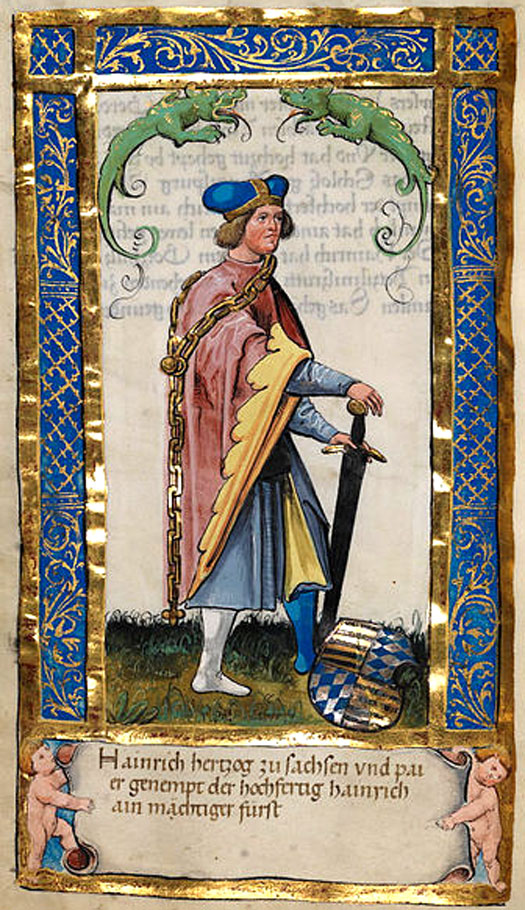 As Henry X of Bavaria and Henry II of Saxony, Henry the Proud was a powerful supporter of Emperor Lothar II in Germany, and an opponent of the Hohenstaufens As Henry X of Bavaria and Henry II of Saxony, Henry the Proud was a powerful supporter of Emperor Lothar II in Germany, and an opponent of the Hohenstaufens |
|
| 1136 |
Henry takes part in a campaign against the kingdom ofSicily which is undertaken by his father-in-law, Emperor Lothar II. Lothar is impressed with Henry's military capabilities during the campaign, and in reward makes him margrave of Tuscany. |
|
| 1137 - 1139 |
The rivalry for the imperial title between Emperor Lothar and his main rival, Frederick II of[Swabia](GermanySwabia.htm#Dukes of Swabia), has a destabilising effect on Germany as a whole. Emperor Lothar and his Hohenstaufen successors inFranconia are supported by Louis I ofThuringia, but Lothar dies in 1137 on the way back from his campaign against the kingdom ofSicily. The election is held to select the next emperor in 1138, but Henry the Proud of is defeated as a candidate by Conrad Hohenstaufen of Franconia. Tensions between Conrad and Henry quickly escalate and he is relieved of Bavaria andSaxony in the same year. He fights on against his Ascanian replacement in Saxony but dies suddenly in 1139 on the eve of a campaign to secure Bavaria. |
|
| 1139 - 1141 |
Leopold |
|
| 1141 - 1156 |
Henry XI Jasomirgott |
|
| 1156 - 1180 |
Henry XII the Lion |
Son of Henry the Proud. Duke Henry III (V) ofSaxony. |
| 1164 |
Despite [Pomerania](EasternPomerania.htm#Duchy of Pomerania) already being Christianised, and increasingly Germanised, bishops and dukes from theHoly Roman empire continue to mount expeditions into Pomerania. The Battle of Verchen in 1164 makes Pomerania a vassal of Henry the Lion. 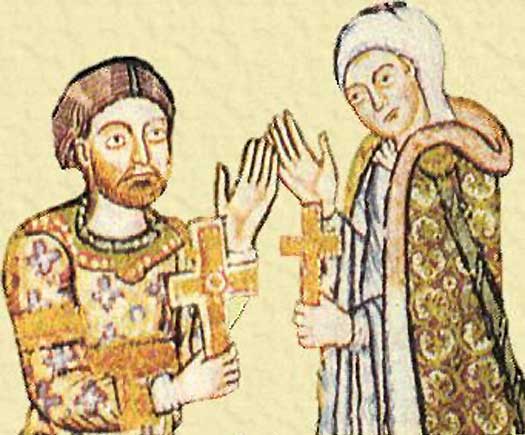 Henry's second marriage was to Matilda, daughter of Henry II of England, but his eventual conflict with Holy Roman Emperor Frederick Barbarossa cost him his lands and titles Henry's second marriage was to Matilda, daughter of Henry II of England, but his eventual conflict with Holy Roman Emperor Frederick Barbarossa cost him his lands and titles |
|
| 1180 |
Henry Welf comes into conflict with the HRE, Frederick Barbarossa. Frederick dispossesses Henry of his lands and passes Bavaria to the Wittelsbachs whileSaxony is divided. The County Palatine of Saxony is given to Louis III, landgrave of Thuringia (he promptly passes it onto his brother, the future Landgrave Herman I, in 1881). Following standard German practice, territory is often sub-divided between brothers, with one always being dominant, and the Bavarians and Saxons were no different. Subsidiary branches are not shown here (but are included in the counting of names, so there will appear to be gaps here). |
|
|
|
|
| Duchy of Bavaria (Wittelsbachs) AD 1180 - 1777 |
|
|
| 1180 - 1183 |
Otto I |
Count of Wittelsbach. |
| 1183 - 1231 |
Louis I the Kelheimer |
Count of the Palatinate (1214). |
| 1231 - 1253 |
Otto II the Noble |
|
| 1253 - 1294 |
Louis II the Severe |
|
| 1290 - 1312 |
Otto III |
King ofHungary (1305-1307). |
| 1294 - 1347 |
Louis IV |
HRE (1314-1347). Senator of Rome (1328). |
| 1313 |
With the death of John Parricide, any claim to the former[Swabian](GermanySwabia.htm#Dukes of Swabia) duchy dies with him. Large areas of its territory have already gone to the established county of[Württemberg](GermanyWurttemberg.htm#County of Wurttemberg) and the margraviate of Baden. Territory formerly belonging to the Alemanni people also later forms parts of[Austria](GermanyAustria.htm#Habsburg Margraves) (Vorarlberg),France (Alsace) and Switzerland, as well as the Bavarian Swabia region of Bavaria. |
|
| 1314 - 1322 |
When Louis IV is elected Holy Roman Emperor in 1314, a minority faction elects Frederick the Fair of [Habsburg](GermanyAustria.htm#Habsburg Margraves) as emperor. Louis defeats Frederick in 1322, but the[Pope](ItalyPopes.htm#Great Schism) refuses to recognise or crown him, so Louis has himself crowned emperor by representatives of the Roman people. 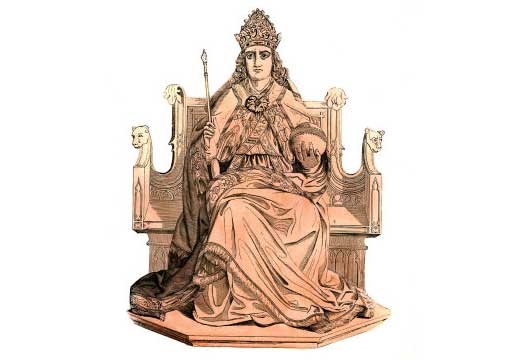 The vigorous king of Bavaria and HRE Louis IV also became king of Italy in 1327 despite many objections and opposition figures, with his strength of will and character being proof of his desire and eligibility to rule The vigorous king of Bavaria and HRE Louis IV also became king of Italy in 1327 despite many objections and opposition figures, with his strength of will and character being proof of his desire and eligibility to rule |
|
| 1328 |
Following the refusal of [Pope](ItalyPopes.htm#Great Schism) John XXII to recognise him asHoly Roman Emperor, Louis IV invades [Italy](ItalyKingdom.htm#Lords of Milan) and sets up Nicholas V as the first anti-pope of the Great Schism. |
|
| 1347 |
Louis is killed in a hunting accident whilst successfully resisting the[Pope](ItalyPopes.htm#Great Schism)'s named replacement for the title ofHoly Roman Emperor. |
|
| 1347 - 1375 |
Stephen II |
|
| 1363 - 1369 |
Archduke Rudolph IV of [Austria](GermanyAustria.htm#Habsburg Archdukes) agrees with the widowed Margaret Maultash, countess of Gorizia-Tyrol, that upon the death of her only son, Meinhard III, he will inherit the county of Tyrol. In the end, Meinhard predeceases his mother and she remains in full command of the county until her own death in 1369, not least because her brother-in-law, Duke Stephen II, invades and holds the county. |
|
| 1375 - 1397 |
John II |
|
| 1397 - 1438 |
Ernest |
|
| 1438 - 1460 |
Albert III |
|
| 1645 - 1508 |
Albert IV the Wise |
|
| 1508 - 1550 |
William IV |
|
| 1545 |
The duchy is reunited when the last subsidiary branch dies out, putting an end to the weakening divisions of territory. 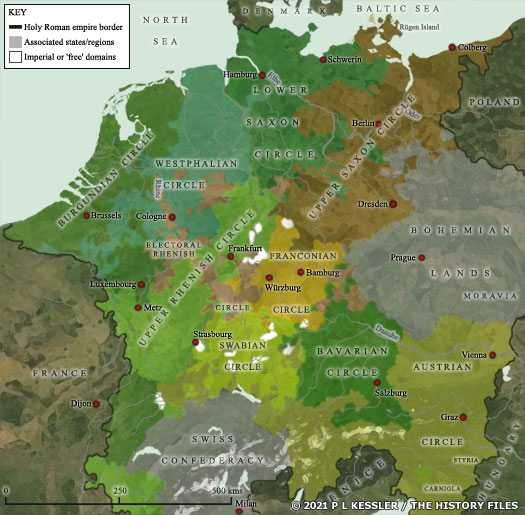 Introduced in 1560, the system of imperial states replaced the now-outdated feudal system, with an imperial circle ('reichskreis') being a regional grouping of the imperial states (click or tap on map to view full sized) Introduced in 1560, the system of imperial states replaced the now-outdated feudal system, with an imperial circle ('reichskreis') being a regional grouping of the imperial states (click or tap on map to view full sized) |
|
| 1550 - 1579 |
Albert V |
|
| 1579 - 1597 |
William V the Pious |
Died 1626. |
| 1581 |
 The election of Ernest, son of the late Albert V, as prince-bishop of Liège (see feature link) begins a run of three consecutive elections from the ranks of the Wittelsbachs. Ernest is succeeded by Ferdinand, son of William the Pious, and then Maximilian Henry, son of Albert VI. A brief break with a compromise candidate is followed by the election of Joseph Clemens, son of Ferdinand Maria. The election of Ernest, son of the late Albert V, as prince-bishop of Liège (see feature link) begins a run of three consecutive elections from the ranks of the Wittelsbachs. Ernest is succeeded by Ferdinand, son of William the Pious, and then Maximilian Henry, son of Albert VI. A brief break with a compromise candidate is followed by the election of Joseph Clemens, son of Ferdinand Maria. |
|
| 1597 - 1651 |
Maximilian I |
Elector (1623). |
| 1651 - 1679 |
Ferdinand Maria |
|
| 1651 - 1654 |
Albert VI |
Regent. Landgrave of Haag. |
| 1654 |
Queen Christina of Sweden causes a scandal when she converts to Catholicism and abdicates the throne. She retires to [Rome](ItalyPopes.htm#Early Modern), while Karl Gustav, son of John Casimir, the Count Palatine of Zweibrücken-Kleeburg is elected as her successor. Aside from King Christoper in the mid-fifteenth century, Karl is the first of the Bavarian Wittelsbach kings of Sweden. |
|
| 1679 - 1726 |
Maximilian II Emmanuel |
|
| 1688 |
Maximilian's forces form part of the imperial army which captures Belgrade from the Ottomans. In the same year the death is reported of Maximilian Henry, archbishop-elector of Cologne, prince-bishop of Hildesheim and of Liège, and son of Albert VI of Bavaria. With this loss, the family's possession of Haag reverts to Bavaria. |
|
| 1726 - 1745 |
Charles Albert |
HRE (1742-1745). |
| 1740 - 1748 |
The War of the Austrian Succession is a wide-ranging conflict that encompasses the North American King George's War, two Silesian Wars, the War of Jenkins' Ear, and involves most of the crowned heads of Europe in deciding the question of whether Maria Theresa can succeed as archduke of [Austria](GermanyAustria.htm#Habsburg Archdukes) and, perhaps even more importantly, asHoly Roman Emperor. Austria is supported by Britain, the [Netherlands](FranceHolland.htm#House of Orange), the Savoyard kingdom ofSardinia, andSaxony (after an early switchover), but opposed by an opportunistic Prussia andFrance, who had raised the question in the first place to disrupt Habsburg control of Central Europe, backed up by Bavaria and Sweden (briefly). Spain joins the war in an unsuccessful attempt to restore possessions lost to Austria in 1715. 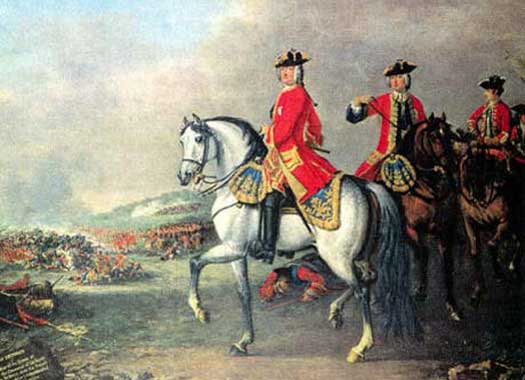 The War of the Austrian Succession saw Europe go to war to decide whether Maria Theresa would secure the throne left to her by her father, but several other issues were also decided as a wide range of wars were involved in the overall conflict The War of the Austrian Succession saw Europe go to war to decide whether Maria Theresa would secure the throne left to her by her father, but several other issues were also decided as a wide range of wars were involved in the overall conflict |
|
| The War of Jenkins' Ear pitches Britain against Spain between 1739-1748. The Russo-Swedish War, or Hats' Russian War, is the Swedish attempt to regain territory lost to Russia in 1741-1743. King George's War is fought between Britain and France in the [French Colonies](../KingListsAmericas/ColoniesFrench.htm#Governors General) in 1744-1748. The First Carnatic War of 1746-1748 involves the struggle for dominance in [India](../KingListsFarEast/IndiaStates.htm#Small States) by France and Britain. Henry Pelham, leader of the English government in Parliament, is successful in ending the war, achieving peace with France and trade with Spain through the Treaty of Aix-la-Chapelle. Austria is ultimately successful, losing only Silesia to Prussia. |
|
|
| 1745 - 1777 |
Maximilian III Joseph |
|
| 1777 |
The line of Bavarian Wittelsbachs dies out with Maximilian. The title passes to the Wittelsbach Electors of the Palatinate. |
|
|
|
|
| Duchy of Bavaria (Palatinate Wittelsbachs) AD 1777 - 1805 This branch of the Wittelsbachs had served as counts and prince electors of the Palatinate since 1329. When the main family line died out in Bavaria in 1777, the title of duke of Bavaria passed to the Palatinate Wittelsbachs. |
|
|
| 1777 - 1799 |
Charles IV Theodore |
Elector of the Palatinate. |
| 1778 - 1779 |
The War of the Bavarian Succession. |
|
| 1799 - 1805 |
Maximilian IV Joseph |
Elector. |
| 1805 |
Bavaria is raised to a kingdom by Napoleon Bonaparte of the [French](FranceFranks.htm#First Empire) First Empire. Maximilian's daughter marries Eugene de Beauharnais, Napoleon's stepson. |
|
|
|
|
| Kingdom of Bavaria AD 1805 - 1918 The [French](FranceFranks.htm#First Empire) Emperor Napoleon Bonaparte did much to clear up the confusing and archaic mass of tiny states in the German territories, forming stronger states with larger territories. One of the strongest was that of the newly formed kingdom of Bavaria, which was raised from a duchy by Napoleon after his defeat of the Third Coalition in the same year. It also gained the [Austrian](GermanyAustria.htm#Habsburg Archdukes %28Lorraine%29) province of the Tyrol - but only until Napoleon abdicated in 1814. (Additional information from History of the Rebellion of 1745-6, Robert Chambers (W & R Chambers, 1869), from The First World War, John Keegan (Vintage Books, 2000), and from External Link: Royal Stuart Society.) |
|
|
| 1805 - 1825 |
Maximilian I Joseph |
Former elector of the duchy of Bavaria. |
| 1806 |
A core of the medieval duchy of Franconia survives under the command of the bishopric of Würzburg. The bishopric also claims the title of duke. This now changes as the bishopric is secularised and its territory is handed to the kingdom of Bavaria, which contains noticeably different dialects and customs from this central German region. |
|
| 1810 |
Following a further[Austrian](GermanyAustria.htm#Habsburg Emperors) defeat in 1809, at the Battle of Wagram, Bavaria agrees to grant the Tyrol to Italy, whileIstria, Dalmatia and Ragusa are incorporated into the new[Illyrian Provinces](EasternCroatia.htm#Illyrian Provinces). |
|
| 1814 |
Bavaria gains territory as a result of the Congress of Vienna. 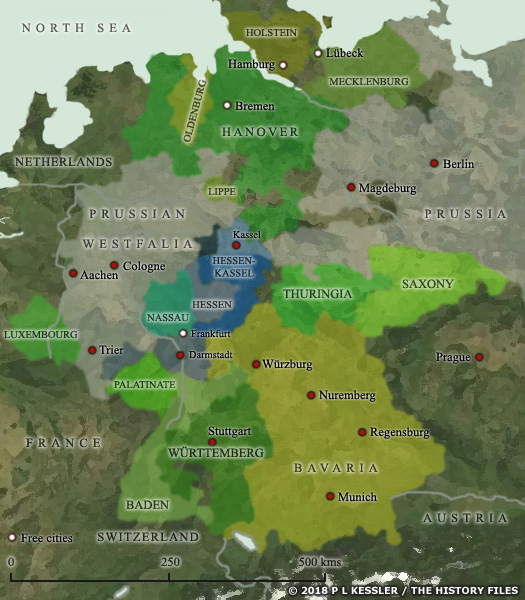 Following the defeat of Napoleon Bonaparte 1814, the Congress of Vienna took on board much of his vital restructuring of the German principalities, with the result that a map of the new Confederation of German States in 1815-1817 looked very different to maps of the previous century (click or tap on map to view full sized) Following the defeat of Napoleon Bonaparte 1814, the Congress of Vienna took on board much of his vital restructuring of the German principalities, with the result that a map of the new Confederation of German States in 1815-1817 looked very different to maps of the previous century (click or tap on map to view full sized) |
|
| 1825 - 1848 |
Ludwig I |
Died 1868. |
| 1832 |
Under the terms of the Convention of London, Prince Otto, son of Ludwig, ascends the newly-created throne of Greece while still a minor, carrying the title 'King of the Hellenes'. He initially rules under the guidance of a three-man regency council, but they prove unpopular and are dismissed. Otto then rules as an absolute monarch. |
|
| 1848 - 1864 |
Maximilian II Joseph |
Son. Brother of Otto, king of Greece (1832). |
| 1864 - 1886 |
Ludwig II the Mad |
Declared insane, deposed, and died mysteriously. |
| 1871 - 1918 |
The kingdom is forcibly included into the German empire by Prussia and effectively becomes a sub-kingdom. |
|
| 1886 - 1913 |
Otto |
Aided by Luitpold, regent (1886-1912), and then Ludwig III. |
| 1913 - 1918 |
Ludwig III |
Deposed. |
| 1913 |
The new king is married to Maria Theresia of Austria-Este, daughter of Maria Beatrice of Savoy, granddaughter of Victor Emanuel I of the kingdom of Sardinia and Savoy, and from 1875 the Jacobite Stuart claimant to the English and Scottish thrones. |
|
| 1914 |
The German empire moves swiftly to support its ally, [Austria-Hungary](GermanyAustria.htm#Habsburg Emperors), in a long-anticipated Great War (later more readily known as the First World War, or World War I). At the start it is successful against theRussian invasion of Prussia, routing their army at the Battle of Tannenberg, and in the west its armies reach the northern outskirts of Paris (occupying Luxembourg along the way) before they are stopped by the armies of Britain and France, together with the small Belgian army.  At the end of October 1914, after a short three month training period with the Bavarian army, a certain Adolf Hitler is transferred as an ordinary infantryman to the front at Geluwe in the Westhoek (near Menin in West Flanders). The day after his arrival, Hitler's regiment attacks the allies across the fields of Geluveld, towards Ypres, as part of the First Battle of Ypres (see feature link). At the end of October 1914, after a short three month training period with the Bavarian army, a certain Adolf Hitler is transferred as an ordinary infantryman to the front at Geluwe in the Westhoek (near Menin in West Flanders). The day after his arrival, Hitler's regiment attacks the allies across the fields of Geluveld, towards Ypres, as part of the First Battle of Ypres (see feature link). |
|
| 1918 |
All German monarchies are abolished upon the defeat of the German empire in the First World War. Bavaria is recreated as a constituent part of the new federal Germany and its future fortunes would be tied to this new political creation. |
|
|
|
|
| Hereditary Kings of Bavaria AD 1918 - Present Day The head of the Wittelsbachs remained the titular successor to the kings of Bavaria, although they were reduced in rank to dukes. The last king, Ludwig III had married Maria Theresia of Austria-Este, granddaughter of Francis V of Modena. Duke Rupprecht and his successors were, in turn, also the senior member of the House of Stuart, and were considered by modern Jacobites to be the rightful ruler of England, Scotland, andIreland. The dukes did not, and still do not, make any claim to the English throne, but the technical claim still exists. The hereditary dukes also continue to add 'duke in Franconia and [ Swabia](GermanySwabia.htm#Dukes of Swabia)' to their titles. |
|
|
| 1918 - 1921 |
Ludwig III |
Former king of [Bavaria](#Kingdom of Bavaria). |
| 1919 |
Germany adopts the democratic 'Weimar constitution' following the abolition of the German empire. This new Germany consists of the former German kingdoms and duchies, all of which have now been abolished, including [Baden](GermanyBaden.htm#Grand Duchy), Bavaria, [Hesse](GermanyHessenDarmstadt.htm#Hereditary Heirs), Lippe,Saxony and [ Württemberg](GermanyWurttemberg.htm#Kingdom of Wurttemberg). |
|
| 1921 - 1955 |
Rupprecht |
Born 1869. Crown Prince of Bavaria (& Scotland). |
| 1933 - 1945 |
The Third Reich ('third empire' of Germany, which claims the first (Holy Roman) and second (German) empires as its forebears in order to attain a level of legitimacy) is established under Adolf Hitler's dictatorial Nazi rule, sweeping away the Weimar republic. The Nazi invasion of Poland on 1 September 1939 is the trigger for the Second World War. With both France and Great Britain pledged to support Poland, both countries have no option but to declare war on 3 September. Hitler subsequently commits suicide in his bunker on 30 April 1945 as Soviet Russian forces overrun Berlin. Nazi Germany surrenders unconditionally on 7 May to the Allies at General Eisenhower's HQ at Rheims in France. |
|
| 1955 - 1996 |
Albrecht |
Son. Born 1905. Duke of Bavaria. |
| 1989 - 1990 |
With the weakening of the Soviet Union and increased calls for reform, the Berlin Wall is pulled down by the people of both halves of the divided city, the border guards taking no action to stop them. The following year, the two Germanies are reunited on 3 October. |
|
| 1996 - Present |
Franz |
Son. Born 14 July 1933. Duke of Bavaria. Unmarried. |
| 2005 |
The conservative Bavarian Cardinal John Ratzinger is electedPope on 19 April. |
|
| Max |
Brother and heir. Born 21 Jan 1937. Duke in Bavaria. |
|
| Luitpold |
Cousin and next in line. Born 14 Apr 1951. Duke in Bavaria. |
|
 |
|
|
 Bavaria's mixed terrain varies from dark forests to alpine mountains in the far south, with an equally mixed population of Celts, Germanics, and Romans forming this new tribal grouping in the fifth century AD
Bavaria's mixed terrain varies from dark forests to alpine mountains in the far south, with an equally mixed population of Celts, Germanics, and Romans forming this new tribal grouping in the fifth century AD Under Charlemagne's leadership, the Franks greatly expanded their borders eastwards, engulfing tribal states, the Bavarian state and its satellite, Khorushka, and much of northern Italy, with the Avars now an eastern neighbour (click or tap on map to view full sized)
Under Charlemagne's leadership, the Franks greatly expanded their borders eastwards, engulfing tribal states, the Bavarian state and its satellite, Khorushka, and much of northern Italy, with the Avars now an eastern neighbour (click or tap on map to view full sized) King Louis 'the Pious' of the Frankish empire attempted to leave the empire intact for his eldest son, Lothar, but the others rebelled at the idea. The treaty of Verdun in AD 843 confirmed the official division of the empire between Charlemagne's three surviving grandsons (click or tap on map to view full sized)
King Louis 'the Pious' of the Frankish empire attempted to leave the empire intact for his eldest son, Lothar, but the others rebelled at the idea. The treaty of Verdun in AD 843 confirmed the official division of the empire between Charlemagne's three surviving grandsons (click or tap on map to view full sized) Germany in AD 962 may have had its new emperor to govern those territories which are shown within the dark black line, but it was still a patchwork of competing interests and power bases (click or tap on map to view full sized)
Germany in AD 962 may have had its new emperor to govern those territories which are shown within the dark black line, but it was still a patchwork of competing interests and power bases (click or tap on map to view full sized) As Henry X of Bavaria and Henry II of Saxony, Henry the Proud was a powerful supporter of Emperor Lothar II in Germany, and an opponent of the Hohenstaufens
As Henry X of Bavaria and Henry II of Saxony, Henry the Proud was a powerful supporter of Emperor Lothar II in Germany, and an opponent of the Hohenstaufens Henry's second marriage was to Matilda, daughter of Henry II of England, but his eventual conflict with Holy Roman Emperor Frederick Barbarossa cost him his lands and titles
Henry's second marriage was to Matilda, daughter of Henry II of England, but his eventual conflict with Holy Roman Emperor Frederick Barbarossa cost him his lands and titles The vigorous king of Bavaria and HRE Louis IV also became king of Italy in 1327 despite many objections and opposition figures, with his strength of will and character being proof of his desire and eligibility to rule
The vigorous king of Bavaria and HRE Louis IV also became king of Italy in 1327 despite many objections and opposition figures, with his strength of will and character being proof of his desire and eligibility to rule Introduced in 1560, the system of imperial states replaced the now-outdated feudal system, with an imperial circle ('reichskreis') being a regional grouping of the imperial states (click or tap on map to view full sized)
Introduced in 1560, the system of imperial states replaced the now-outdated feudal system, with an imperial circle ('reichskreis') being a regional grouping of the imperial states (click or tap on map to view full sized) The election of Ernest, son of the late Albert V, as prince-bishop of Liège (see feature link) begins a run of three consecutive elections from the ranks of the Wittelsbachs. Ernest is succeeded by Ferdinand, son of William the Pious, and then Maximilian Henry, son of Albert VI. A brief break with a compromise candidate is followed by the election of Joseph Clemens, son of Ferdinand Maria.
The election of Ernest, son of the late Albert V, as prince-bishop of Liège (see feature link) begins a run of three consecutive elections from the ranks of the Wittelsbachs. Ernest is succeeded by Ferdinand, son of William the Pious, and then Maximilian Henry, son of Albert VI. A brief break with a compromise candidate is followed by the election of Joseph Clemens, son of Ferdinand Maria. The War of the Austrian Succession saw Europe go to war to decide whether Maria Theresa would secure the throne left to her by her father, but several other issues were also decided as a wide range of wars were involved in the overall conflict
The War of the Austrian Succession saw Europe go to war to decide whether Maria Theresa would secure the throne left to her by her father, but several other issues were also decided as a wide range of wars were involved in the overall conflict Following the defeat of Napoleon Bonaparte 1814, the Congress of Vienna took on board much of his vital restructuring of the German principalities, with the result that a map of the new Confederation of German States in 1815-1817 looked very different to maps of the previous century (click or tap on map to view full sized)
Following the defeat of Napoleon Bonaparte 1814, the Congress of Vienna took on board much of his vital restructuring of the German principalities, with the result that a map of the new Confederation of German States in 1815-1817 looked very different to maps of the previous century (click or tap on map to view full sized) At the end of October 1914, after a short three month training period with the Bavarian army, a certain Adolf Hitler is transferred as an ordinary infantryman to the front at Geluwe in the Westhoek (near Menin in West Flanders). The day after his arrival, Hitler's regiment attacks the allies across the fields of Geluveld, towards Ypres, as part of the First Battle of Ypres (see feature link).
At the end of October 1914, after a short three month training period with the Bavarian army, a certain Adolf Hitler is transferred as an ordinary infantryman to the front at Geluwe in the Westhoek (near Menin in West Flanders). The day after his arrival, Hitler's regiment attacks the allies across the fields of Geluveld, towards Ypres, as part of the First Battle of Ypres (see feature link).